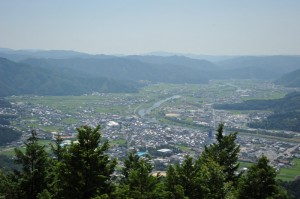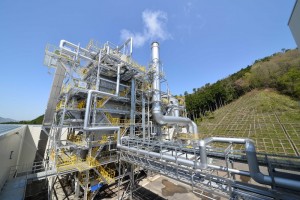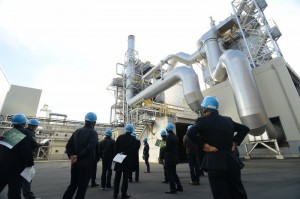Sustainable industries – Renewable energy – Green technologies – Supporting communities – Local economic development
Maniwa city is located in the northern part of Okayama Prefecture and is in the centre of the Chugoku mountain range, stretching about 30km from east to west and 50km from north to south, with an area of about 828 km² and population of 47,000. Maniwa City has a variety of rich natural resources, and the city government is progressing with its primary initiative of developing the so called ‘Maniwa Lifestyle’ city branding of sustainable communities. It is the largest of any local government in Okayama prefecture with approximately 79% of its area comprised of forests.
Historically, the city and area around Maniwa grew through forestry, from Tatara Metalworking (Wikipedia link) using local wood for fuel, to the modern timber industry servicing demand for wood in Western Japan. Now, a long term ‘biomass town framework’ aims at future use of the abundant wood resources, with zero waste policies which contribute to the cultivation of forests and to develop a so called ‘Biomass Town Maniwa’ concept with cooperation from industry, government, and academia.
The Maniwa city area possesses the right natural environment for biomass wood based business with great potential for developing a carbon neutral local economy, through the cyclical use of tree planting, cultivation, and using timber for biomass energy. Carbon neutral policy promotes the burning of plant material, such as trees, which generate the greenhouse gas CO2, but which is absorbed by the growth of forests in the area, not contributing to global warming.
Through the efficient use of plentiful renewable natural resources in the region, the city believes it can support sustainability of the existing natural environment and in the future.
Japan actively started to import timber from overseas in 1964 causing a major crash in the price of domestic wood. However, in Maniwa, various efforts focus on the abandoned forest tracts as a resource for biomass. In the future, the aim is to profit from biomass related business and reinvest in the forest.
The entire process from forestry to finished products can be completed within the Maniwa region. In addition to the forestry resources, the Maniwa area also has raw wood markets, timber yards, and markets for finished products. The industry is lead by local private industry but recent government and academics have joined in a cooperative relationship to create the system in existence today.
In 1993, young leaders in local business and other areas established the “21st Century Maniwa School” organisation. Since then, experts from many backgrounds have been invited from other regions and the movement became registered as an NPO in 2002. The NPO promotes a biomass based town plan. The main themes for the 21st Century Maniwa School, born out of the risk of a decline in industry due to the construction of expressways, are;
・Conserve the scenery of the town
・Create a cyclical society
At the time, 78,000 tons of timber waste was generated in the Maniwa region annually, according to a 2000 survey. In response, industrial cooperation developed around forestry and timber industries to make effective use of those waste byproducts. Efforts began to develop a cyclical system wood resources and to regenerate the regional community as a “cluster structure for wood resource utilising industries” with the aim to involve other regions as well.
The Maniwa region set a goal in 2006 to also use waste from livestock and food scraps for biomass and a framework was created to achieve this, with certification as a biomass town given by the national government to encourage local stakeholders to cooperate and become connected in education, welfare, technology, and culture. Maniwa is shifting away from energy sources brought into the community to producing and consuming within the town using wood biomass as an opportunity to re-calibrate forestry resources and invigorate forestry, with the focus on rebuilding the mountain community.
Toward the future of Maniwa
‘Maniwa City Biomass Policy Section’ hold town meetings and classes offering people the experience of future goals of Biomass Town Maniwa, with participants from children to adults from all parts of the community who can deepen their understanding and interest in the issues of biomass.
The issues faced when trying to use wood resources in a sustainable cycle in the Maniwa region are cost, methods, and technology. To address this, Maniwa city carried out practical trials in cooperation with the New Energy and Industrial Technology Development Organisation (NEDO), a Japanese semi-governmental agency established in 1980 to promote the development and introduction of new energy technologies. Further, to establish a stable supply of biomass, the ‘Maniwa Biomass Collection Centre’ was established in April 2009. This centre processes debris from the forest and bark and wood chips from timber processing for use as fuel or other resources, meaning unused wood materials and waste has been given extra added value.
2010 was an important year for the city with two major developments to support biomass industries in the area. A Biomass Lab was established by the City in April 2010 in cooperation with Okayama Prefecture as a site for joint research on biomass fuel refining, for training personnel working in biomass related businesses, and for supporting the creation of new biomass based enterprises.
The “Maniwa City Biomass Refinery Project Promotional Committee” was established in June 2010 for the creation of a biomass refinery project based on private initiative and through cooperation between industry, academia, and government, with participation from research organisations, universities, companies, the national and prefectural government, and related organisations. The organisation is working for the promotion of a biomass refinery in the Maniwa region.
Maniwa City Hall plans to further develop its model over the years with the aim of being an ‘Advanced Biomass Town’, able to offer best practice in sustainability and renewable energy for Japan and other communities worldwide.





